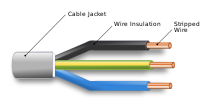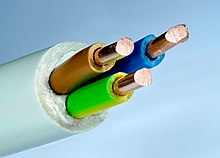Introduction and Etymology
– The term ‘cable’ originally referred to armoured submarine telegraph cables.
– Armouring was added to prevent damage to the cables.
– The term was later extended to any bundle of electrical conductors.
– It is now also applied to telecommunications cables with fibre-optic cores.
– The term ‘cable’ is used for both armoured and non-armoured electrical conductors.
Uses
– Electrical cables are used to connect devices and transfer electrical signals or power.
– Long-distance communication takes place over undersea communication cables.
– Power cables are used for bulk transmission of alternating and direct current power.
– Electrical cables are extensively used in building wiring for lighting, power, and control circuits.
– Cable assemblies can be used to connect many terminals together.
Characteristics
– Any current-carrying conductor radiates an electromagnetic field.
– Cable lengths should be kept short to minimize unwanted transmission of energy.
– Cables should be routed away from sources of electromagnetic interference.
– Shielding, coaxial geometry, and twisted-pair geometry are design techniques used to minimize electromagnetic pickup and transmission.
– Shielding, such as foil or wire mesh, can decouple wires from external electrical fields.
Fire Protection
– Electrical cable jackets can be made of fire-resistant materials.
– Fire tests are conducted to ensure cable insulation does not contribute to the spread of fire.
– Certain cables used in installations are designed to resist fire and prevent its rapid spread.
– Cable jackets can be made to withstand high temperatures.
– Fire-resistant cable jackets help protect people from electric shock and equalize stress on the cable insulation.
Organization and Fastening
– Cables can be securely fastened and organized using trunking, cable trays, cable ties, or cable lacing.
– Continuous-flex or flexible cables used in moving applications can be secured using strain relief devices or cable ties.
– Proper cable management helps prevent damage to cables and ensures efficient operation.
– Cable ties are commonly used to bundle and secure cables together.
– Cable trays provide a structured pathway for cables and allow for easy access and maintenance. Source: https://en.wikipedia.org/wiki/Electrical_cable
This article needs additional citations for verification. (September 2017) |
An electrical cable is an assembly of one or more wires running side by side or bundled, which is used as an electrical conductor, i.e., to carry electric current. One or more electrical cables and their corresponding connectors may be formed into a cable assembly, which is not necessarily suitable for connecting two devices but can be a partial product (e.g. to be soldered onto a printed circuit board with a connector mounted to the housing). Cable assemblies can also take the form of a cable tree or cable harness, used to connect many terminals together.


